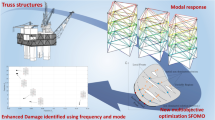Abstract
The need for global damage detection methods that can be applied in complex structures has led to the development of methods that examine the structural dynamic behavior. The damage detection problem can be considered as a inverse problem with minimization of a objective function. For those reasons, a new nature-inspired optimization method based on sunflowers’ motion is introduced. The proposed sunflower optimization algorithm (SFO) technique is a population-based iterative heuristic global optimization algorithm for multi-modal problems. Compared to traditional algorithms, SFO employs terms as root velocity and pollination providing robustness. The new method is then applied in an inverse problem of structural damage detection in composite laminated plates.








Similar content being viewed by others
References
APDL AM (2010) Mechanical applications theory reference. ANSYS Release 13
Bayraktar Z, Komurcu M, Bossard JA, Werner DH (2013) The wind driven optimization technique and its application in electromagnetics. IEEE Trans Antennas Propag 61(5):2745–2757
Chou J-H, Ghaboussi J (2001) Genetic algorithm in structural damage detection. Comput Struct 79(14):1335–1353
Daei M, Mirmohammadi SH (2015) A flexibility method for structural damage identification using continuous ant colony optimization. Multidiscip Model Mater Struct 11(2):186–201
Gerist S, Maheri MR (2016) Multi-stage approach for structural damage detection problem using basis pursuit and particle swarm optimization. J Sound Vib 384:210–226
Gomes GF (2016) Damage detection in laminated composite materials via optimization techniques and dynamic parameter. Master thesis, Federal University of Itajubá
Gomes GF, Diniz CA, da Cunha SS, Ancelotti AC (2017) Design optimization of composite prosthetic tubes using GA-ANN algorithm considering Tsai-Wu fail criteria. J Fail Anal Prev 17(4):740–749
Gomes GF, Mendéz YAD, Alexandrino PDSL, da Cunha, SS, Ancelotti AC 2018. The use of intelligent computational tools for damage detection and identification with an emphasis on composites—a review. Compos Struct 196:44–54
Gomes GF, Mendéz YAD, da Cunha SS, Ancelotti AC (2018) A numerical–experimental study for structural damage detection in CFRP plates using remote vibration measurements. J Civil Struct Health Monit 8(1):33–47
Gomes GF, Mendez YAD, Alexandrino PDSL, da Cunha, SS, Ancelotti AC 2018. A review of vibration based inverse methods for damage detection and identification in mechanical structures using optimization algorithms and ANN. Arch Comput Methods Eng. https://doi.org/10.1007/s11831-018-9273-4
Hao H, Xia Y (2002) Vibration-based damage detection of structures by genetic algorithm. J Comput Civil Eng 16(3):222–229
Kang F, Li J (2015) Artificial bee colony algorithm optimized support vector regression for system reliability analysis of slopes. J Comput Civil Eng 30(3):04015040
Kang F, Li J-J, Xu Q (2012) Damage detection based on improved particle swarm optimization using vibration data. Appl Soft Comput 12(8):2329–2335
Kang F, Li J, Liu S (2013) Combined data with particle swarm optimization for structural damage detection. Math Probl Eng 2013:1–10
Kang F, Xu Q, Li J (2016) Slope reliability analysis using surrogate models via new support vector machines with swarm intelligence. Appl Math Model 40(11–12):6105–6120
Li X, Zhang X, Li C, Zhang L et al (2013) Rolling element bearing fault detection using support vector machine with improved ant colony optimization. Measurement 46(8):2726–2734
Majumdar A, Maiti DK, Maity D (2012) Damage assessment of truss structures from changes in natural frequencies using ant colony optimization. Appl Math Comput 218(19):9759–9772
McInnes CR (1999) Solar radiation pressure. In: Solar sailing. Springer, London, pp 32–55. https://doi.org/10.1007/978-1-4471-3992-8_2
Mehrjoo M, Khaji N, Ghafory-Ashtiany M (2013) Application of genetic algorithm in crack detection of beam-like structures using a new cracked Euler–Bernoulli beam element. Appl Soft Comput 13(2):867–880
Mitchell M (1998) An introduction to genetic algorithms. MIT press
Rao SS, Rao SS (2009) Engineering optimization: theory and practice. Wiley, Hoboken
Santos A, Silva M, Santos R, Figueiredo E, Sales C, Costa JC (2016) A global expectation-maximization based on memetic swarm optimization for structural damage detection. Struct Health Monit 15(5):610–625
Shirazi MN, Mollamahmoudi H, Seyedpoor S (2014) Structural damage identification using an adaptive multi-stage optimization method based on a modified particle swarm algorithm. J Optim Theory Appl 160(3):1009–1019
Silva M, Santos A, Figueiredo E, Santos R, Sales C, Costa JC (2016) A novel unsupervised approach based on a genetic algorithm for structural damage detection in bridges. Eng Appl Artif Intell 52:168–180
Yang X-S (2010) Engineering optimization: an introduction with metaheuristic applications. Wiley, Hoboken
Yang X-S (2012) Flower pollination algorithm for global optimization. In: International conference on unconventional computing and natural computation. Springer, Berlin, pp 240–249
Zhao X, Gao H, Zhang G, Ayhan B, Yan F, Kwan C, Rose JL (2007) Active health monitoring of an aircraft wing with embedded piezoelectric sensor/actuator network: I. Defect detection, localization and growth monitoring. Smart Mater Struct 16(4):1208
Acknowledgements
The authors would like to acknowledge the financial support from the Brazilian agency CNPq - Conselho Nacional de Desenvolvimento Científico e Tecnológico and CAPES - Coordenação de Aperfeiçoamento de Pessoal de Nível Superior.
Author information
Authors and Affiliations
Corresponding author
Additional information
Publisher's Note
Springer Nature remains neutral with regard to jurisdictional claims in published maps and institutional affiliations.
Rights and permissions
About this article
Cite this article
Gomes, G.F., da Cunha, S.S. & Ancelotti, A.C. A sunflower optimization (SFO) algorithm applied to damage identification on laminated composite plates. Engineering with Computers 35, 619–626 (2019). https://doi.org/10.1007/s00366-018-0620-8
Received:
Accepted:
Published:
Issue Date:
DOI: https://doi.org/10.1007/s00366-018-0620-8




